|
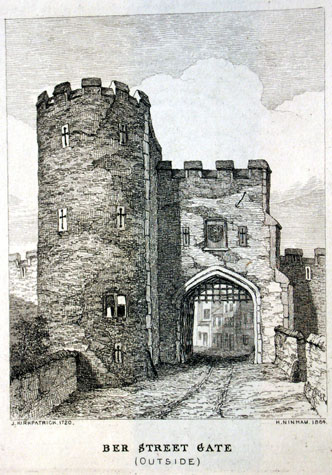
[2] The outside of Ber Street Gate from the south by H Ninham from
an early-18th century drawing by John Kirkpatrick. [Norwich
Castle Museum and Art Gallery 1954.138, Todd 5, Norwich, 117a]
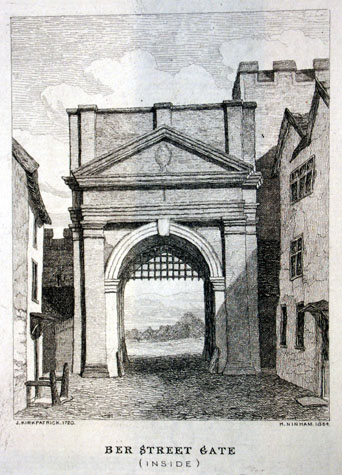
[3] The inside of Ber Street Gate from the north by H Ninham from
an early-18th century drawing by John Kirkpatrick. [Norwich
Castle Museum and Art Gallery 1954.138, Todd 5, Norwich, 117b]
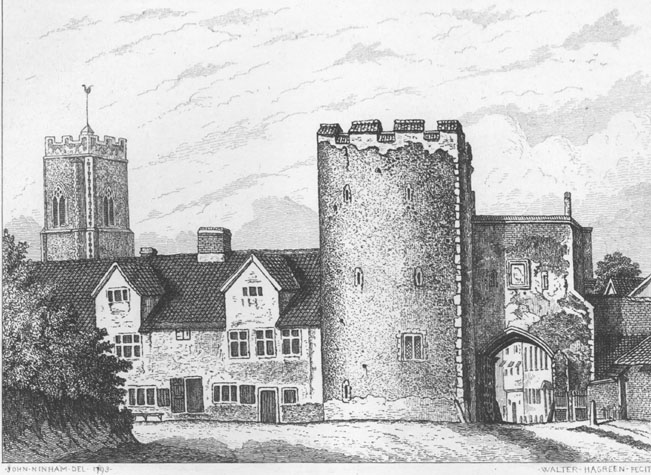
[4] The outside of Ber Street Gate from the south in 1793 by John
Ninham published by Robert Fitch in 1861.
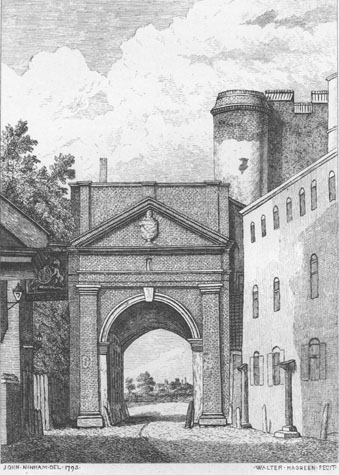
[5] The inside of Ber Street Gate from the north in 1793 by John
Ninham published by Robert Fitch in 1861.
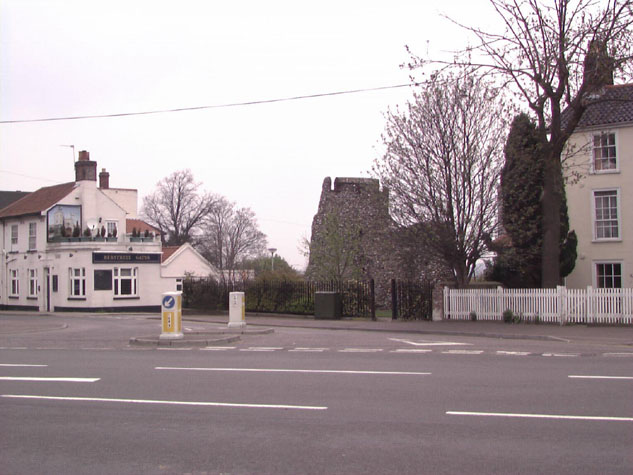
[6] The surviving wall to the east of the site of Ber Street Gate.
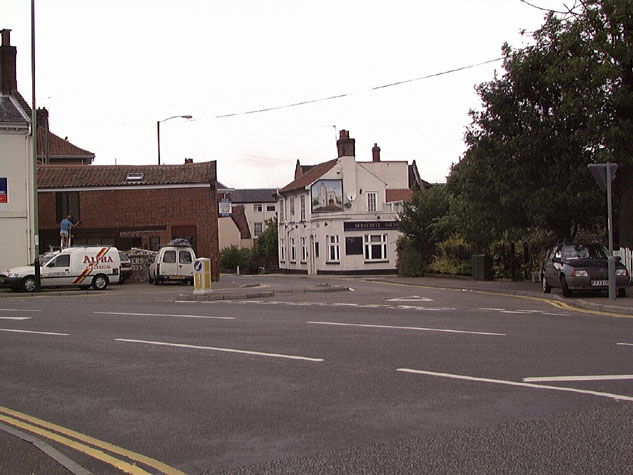
[7] View from the south looking into the city up Ber Street from
the outer side of the ditch. The Gate was across the road and
projected beyond the front line of the brick building on the left.
The line of the wall to the west of the gate survives as the rear or north
wall of the brick building.
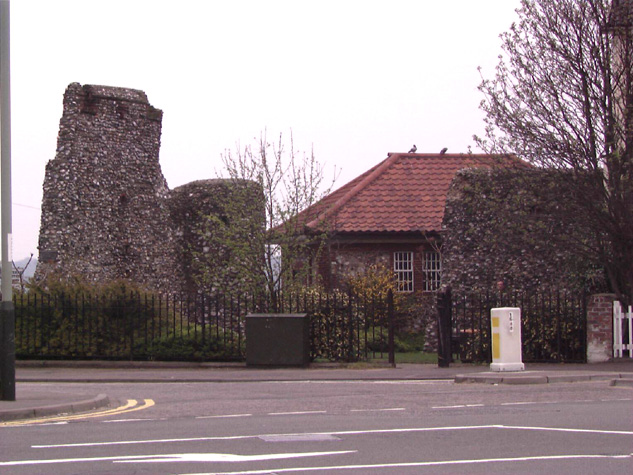
[8] View east across the site of the gate on the line of the ditch
looking towards the surviving wall at Richmond Hill.
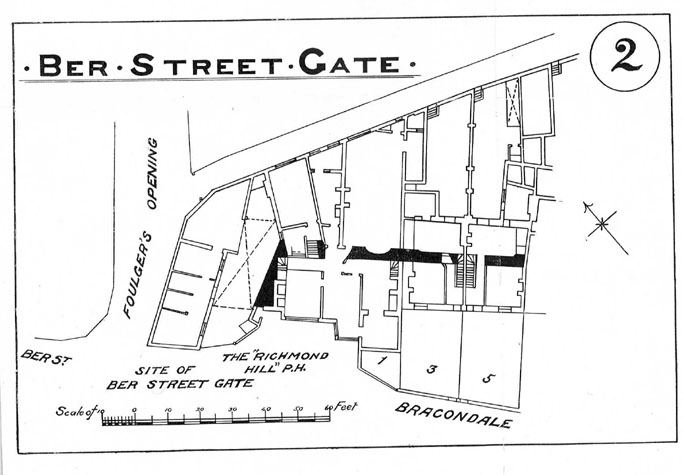
[9] Map of the site of the gate published in the report of 1910.
|
General description
Kirkpatrick's views of the gate in 1720 were copied by Henry Ninham.
[NCM Todd Collection, vol. II, box 5, page 117] The view from the
south, showing the front of gate towards the ditch, has a single large
tower to the west of at least three stories. [2] This was of semicircular
plan to the outside and was crenellated and had cross-shaped loops to
the first and second-floor levels. The form of these loops imply a date
for the work in the 14th century rather than earlier. This might suggest
that the towers were added to an earlier and simpler gate.
Level with the springing of the arch was a cross-mullioned window
that must, on stylistic grounds, have been secondary and below this,
almost at ground level was another single cross-shaped loop. This
low-level loop may have lit an undercroft in the tower. The archway
appears to have a moulded stone surround with a four-centred head and
above, at chamber level, was a central coat of arms flanked by loops.
The parapet level over the arch was crenellated with four merlons.
At the south east corner was an angled buttress with off sets. This
buttress would have been added after the east tower was removed.
Beyond the gate to the east and set back slightly is part of the wall
with battlements...part of the section of wall that still survives at
Ber Street. [see Report 30] The crenellated wall appears to be primary
which would suggest that the gateway was asymmetrical with just the one
tower to the west and no answering tower to the east. This seems slightly
implausible and the answer may only be resolved by archaeological
excavation. However, the wall just beyond Ber Street does turn to head
south quite close to the wall and space for a second tower would be
relatively restricted.
The view also shows a high parapet wall on each side of the gate,
that on the west meeting the tower at the centre of the arc of the front
and that on the west meeting the gate at the centre of the inner angle
of the buttress. These walls, a form of barbican, were the barriers
between the bridge or causeway up to the gate and the drop into the deep
ditch on either side.
The view of the inside of the gate shows the main block with the
archway refaced in brick with a pediment supported on pilasters.
[3] Above the pediment was a high parapet with pilaster strips at the
centre and inset from each end. The archway was closed with a portculis.
John Ninham's drawings of the gate in 1792 (later published by Robert
Fitch in 1861) show that some changes had been made to the gate and the
state of the gate had deteriorated. [NCM Fitch Collection 1760.76.94]
On the outside of the gate the battlements over the arch had been removed
and the wall capped with tiles. [4 & 5] The parapet to the bridge on
the west side had been removed and it appears that the ditch had been
filled in and houses with gabled dormers built against the wall. The
houses appear to be of 17th-century date with cross mullioned windows
and this suggests that possibly the Kirkpatrick drawings or the engravings
had been edited and some features omitted.
Robert Fitch records that on the outside of the gate was set the City
arms in plaster which was painted and had the inscription:
REPARATA TEMPORE
MAIORALTIS ROBERTI
FREEMAN. ARMI. ANNO DNI
1680
On a stone on 'the right hand' was
REPARATA TEMPORE
SAMUELIS WARKEHOUSE
ARMIGERI MAIORIS
CIVITAT NORWICI
ANNO DNI 1699.
In the view of the city side of the gate, John Ninham shows the
pedimented arch with a large urn within the pediment. To the east,
above the roof line of a substantial three-storey house on the west
side of Ber Street close to the gate, is shown the upper part of the
surviving tower. Ninham shows clearly a sloping roof or possibly just
the high angled parapet of the steps that would have led down from the
upper chamber of the tower onto the wall walk to the west. He also
shows a projecting circular stair turret against the north-east corner
of the tower. This appears to have served the second floor chamber
or 'solar' of the tower and appears not to have risen higher
to give access to the roof of the tower.
Documentary evidence
The first references to Ber Street Gate are found in documents in the
reign of Henry III in the second and third quarters of the 13th century
in leases relating to Butter Hill. Blomefield, citing the last leaf of
the Book of Customs noted that at that time there were 27 battlements
on the gate and wicket, and between there and 'St Steven's gate
in the towers and walls are 307.' [Blomefield, page 98]
The remodelling of the gate financed by Richard Spynk is described
briefly in an account of his work produced in 1343 and transcribed and
published by Tingey and Hudson. This work included 'at Berstrete
Gate the portcullis with the machinery, and the gate covered with timber,
board and lead, and bars and chains at the entrance ... And at the two
towers of Berstrete Gate, at the low tower a solar of timber, board and
lead, and at the high tower a solar of timber and board, and another
solar above with timber, board and lead.' [Extract from The Old
Free Book, Hudson & Tingey, Vol. II, pages 217- 219] The work
on the towers was jointly financed by the city. Presumably the tower
with two solars is the three-storey tower shown on the drawing by Ninham
and the lower tower was presumably on the east side of the gate and had
been demolished by the 18th century. The construction of solars and the
use of timber is slightly perplexing but Philip Dixon of Nottingham
University has pointed out that accounts for defences elsewhere in
England indicate that timber was used on the back part of semicircular
towers or to form upper platforms. This timber could be removed and
stored carefully to extend its life when there was no threat of attack.
Many of the towers and the gates in Norwich were fitted out with at least
some form of accommodation and this was, in later centuries, rented
out or used by Hermits.
Treasurer's Accounts for 1385-6 record that John Elmswell was
paid 2s for 'making the ditch between the great Tower and Berstrete
Gates. [Hudson & Tingey, vol. II, page 48] Presumably this was
clearing the ditch rather than excavating a new ditch as the charge
involved is relatively small.
In 1460 three soldiers stood on guard at the gate, and the ancient
assessment of Agistment for the Walls from 1451 and 1481 showed
that the residents of Berstrete were responsible for repairs from the
corner of Berstreet gates, and the walls and towers to the Iron Door.
[Liber Albus, f. 177; Hudson & Tingey, vol. II, pages 313-15]
In 1508 Alderman Robert Gardiner bequeathed �10 'to the
Reparacon of Berstrett gats and to the Walles of the same Ward.'
During Kett's rebellion of 1549 Ber Street Gate was burnt by the
rebels [Blomefield, page 244] and in 1558 the gate was repaired, as
well as the walls adjoining, 'to the cost of 43 (pounds) and
upwards.' [Blomefield, page 276] Could that be when an east
tower was removed?
The Tonnage Books show that orders were given partly to pull down
and rebuild the gate, facing it in red brick, in 1727. The gate and
the walls were to be built 'from the foundation to the top of the
arch, 2 feet 8 inches thick, at 2s 6d per yard; and from the top of the
arch upwards, 2 feet thick, at 2 s per yard'. The wall was to be 3
feet thick, and 15 high; and the foundations to be 2 feet into the
ground and four feet thick. The work was to be carried out in 3 months.
[N.R.O. NCR Case 19 Shelf C; Fitch, page 7] Also in 1727 it was ordered
that a lean-to be built against 'the Great Tower at Ber Street
Gate'. This lean to is shown on a sketch of the gate drawn by John
Carter in 1786 and engraved by J Walmsley and published in 1847.
[History of the History and Antiquities of Norfolk and the City of Norwich,
Proceedings of the Archaeological Institute opposite page 136]
In 1806 a report was made as to the occupants of the gates. This
revealed that Ber Street Gate had been used for some time as an Ordnance store
(ibid.). In 1808 the gate was demolished.
Map evidence
Cleer's map of 1696 shows the gateway with two circular towers
though this may be a graphic convention. The pair of towers are repeated
on Hoyles map of 1728 which, in theory, post dates the rebuilding of the
gate and postdates Kirkpatrick's drawing. Again the convention of a
pair of towers is repeated on the map by Corbridge in 1747 indicating
that these maps were derivative.
Hochstetter's map of 1789 shows clearly that the wall survived on
either side of the gate. On that map Ber Street is marked as Berg
Street. The ditch to the west had been filled in and the ditch to the
east and south had been planted with garden plots as far as the tower at
the junction of Bracondale Road where the ditch ran down Carrow Hill.
The site of the gate
Ber Street is no longer a main entry into the city though the
traffic is nevertheless relatively heavy. [6] The road is narrow with
parts of the wall surviving right up to the road on both sides. [29-01 Map]
On the west side is a two storey brick outbuilding in the rear yard of
number 244 Queen's Road. [7] It was probably a carriage house
and dates from the 19th century but is built against and over what
appears to be a flint boundary wall. This flint wall does not appear
to include medieval fabric above ground but is certainly on the line
of the defensive wall that ran from Ber Street Gate to Brazen Doors.
The house on Queen's Road is built over the line of the ditch and
actually has a cellar, presumably taking advantage of this.
On the east side of Ber Street is a small public garden where an
important section of the city wall survives. [8] The wall here turns
sharply where the ditch and wall continued south towards the Black Tower.
The wall here is important because it survives for its full height up
to the parapet ... the only section of wall where the brick work of the
merlons survives. This section of the wall was buried within the
Richmond Hill public house which was demolished after 1910 and is
now the site of the garden. [9]
The change of alignment of the wall at Ber Street is easy to
explain in practical terms. The ditch in front of the gate would
have been crossed by a bridge with one or two arches. Generally,
it is easier to build a bridge directly across a ditch or river at
right angles. Here the direct line of Ber Street running north south
took precedence and the ditch running from north west to south east
was turned for a short distance to run west to east so that the bridge
and road could be built straight across.
If funds should be available for any archaeological work on this
site then an excavation on the east side of the road might uncover
the east side of the gate and could confirm the arrangement of an
east tower.
A pipe trench for road works in 1976, underneath the position of
the gate tower, immediately to the west of the preserved section of
the wall 'cut through a massive, flint in yellow mortar wall,
presumably part of the gate.' [TG2354807712 SMR NF20]
An information panel in the gardens could not only explain about
the features of the surviving wall but could also include an
illustration of the gate and an explanation about the ditch and
the appearance of the wall in its original setting.
BIBLIOGRAPHY:
Blomefield, Francis, An Essay Towards the Topographical History of the
County of Norfolk, vol. III: The History and County of Norwich Part I
(London: W. Bulmer, 1806)
Blyth, G.K., The Norwich Guide and Directory (London: R. Hastings;
Norwich: Josiah Fletcher, 1842)
Buckler, J., 'Ber Street Gate, Norwich', NCM 1941.12.11:INT
Collins, Arthur E., The Walls of Norwich (City and County of Norwich,
Norwich: Jarrold & Sons, 1910)
Fitch, Robert, Views of the Gates of Norwich made in the years 1792-3 by
the Late John Ninham (Norwich: Cundall, Miller, and Leavins, 1861)
Hudson, William, and Tingey, John C., The Records of the City of
Norwich,
vol. II (Norwich & London: Jarrold & Sons, 1910)
Pococke, Edward, 'Sixteen Drawings of the Gates of Norwich', NCM
1955.219:IN
DOCUMENTARY REFERENCES:
N.R.O. Book of Customs (last leaf)
N.R.O. MF/RO 29/3 f. 177 (Liber Albus)
N.R.O. Case 19 Shelf C (Tonnage Books, 1720-1836)
ARCHAEOLOGICAL REPORTS:
SMR NF20 1976 Pipe trench in pavement cut through massive flint in
yellow mortar wall presumably part of the gate.
Jope, E.M., 'Excavations in the City of Norwich, 1948', Norfolk
Archaeology, 30 (1952): 2870323, esp. pages 292-297
HISTORIC ILLUSTRATIONS IN THE DATABASE:
Norwich Castle Museum and Art Gallery:
Ninham, Henry, 1864, from John Kirkpatrick, 1720, 'Ber Street Gate', NCM
Todd Collection, vol. II, box 5, page 117
Ninham, John, 1792, 'Ber Street Gate, Inside', NCM Fitch Collection
1760.76.94
Ninham, John, 1792, 'Ber Street Gate, Outside', NCM Fitch Collection
1759.76.94
|
